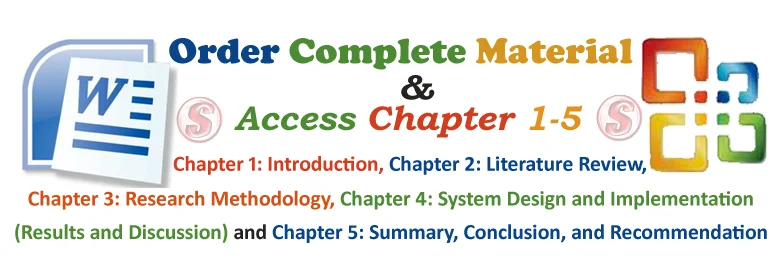1.1 Introduction
The performance of the public service towards national development is no doubt the most tasking challenges that the government of Nigeria is facing today. The Public Service reflects the state of the nation and no nation has been able to advance beyond its Public Service. Studies have shown that no nation can attain sustainable development for the enhancement of the living standard of the people without a properly organized public service to implement government policies. Public services are seen as so important that for moral reasons, their universal provision should be guaranteed. Nigeria is an endowed nation with material and human resources enough to drive her to socio-political and economic development.
As a prelude to other parts of this study, this chapter will discuss the background upon which this study was initiated, the statement of problems that led to this study, the Aim and Objectives of the study. Others are Significance of the study, Scope of work, Research hypothesis and questions, Limitations of the Study and Definition of technical terms.
1.2 Background of Study
With a population of over 180 million hard working and very resilient Nigerians, a land mass of nearly one million square kilometers that hold great potentials for all forms of agriculture, the 7th largest producer of crude oil, the world’s 5th largest proven natural gas reserve and a plethora of solid minerals, Nigeria possess what it takes to be among the world’s most prosperous nations (Achimugu et al., 2013).
Performance systems, in various forms, have been employed for nearly two millennia. In the third century AD, the Chinese were not only using performance appraisal systems but were critiquing each other been biases in their evaluations of their Civil Servants. During the Industrial Revolution of the 18th century, factory managers became aware of the importance of their Civil Servants’ performance on their production outputs. Public Service Public service is a body or department in the executive arm of government with the responsibility of assisting in the planning and implementation of government policies. It is not profit-oriented but an institution established to deliver essential services to the people (Arowolo, 2012).
Arowolo (2012) argued that if delivery of social services is the chief reason why there is public service, and development is a function of amount of social services that a state can provide for its citizens, then public service is the tool by which development is attained. Therefore, development is tied to public service. However achieving development in public service is a function of the environment which the public service finds itself-ecosystem. It can indeed be difficult to determine in what sense precisely the service in question was originally called public. The public service is a catalyst for national development. It provides the required human and material resources needed to accelerate the growth and development.
Douglas (2009) on civil service efficiency stated that had it not been for the widely reported mistakes and blunders, people might be thinking that we now have a much improved level of civil service efficiency. But what has let them down is not the efficiency, but the quality of the outputs. In other words the civil service might well be more efficient than a decade ago but it is less effective (Douglas, 2009). Thus, the author stated that efficiency indicates how well an organization uses its resources to produce goods and services.
Public service performance appraisal is an evaluation of current performance or effectiveness against the key objectives using the measurement as the basis for factual evidence. (Chukwuemeka, 2009) Includes that performance evaluation should be able to establish the areas and priorities of deficiency and analyze their causes and proper possible remedies. The research also put forward that in the private administration, appraisal for performance is based on earned profit, but in the public administration, it is always subjective. Public service performance appraisal is an important means by which organizations improve their chances of attaining their key operational goals.
Therefore, in Rivers State Television where the research was carried out, the activities that was conducted is to know the Public Service Performance in a Dysfunctional Environment.
1.3 Statement of Problems
Investigation revealed that the problem with the public service in developing countries is synonymous with one another, a visit or engagement with the Nigerian public service has been popularly characterized with criticism, it has in most cases left empirical experience of inefficiency, ineptitude, ineffectiveness, staff lackadaisical attitude, red tapism and corruption.
Ewuim et al., (2016) further argue that public service delivery in Nigeria has been described as poor, inefficient and ineffective. It is often subject of ridicule because of its rigidity. There are problems of corruption, transparency and accountability, high cost of administration and wastage.
1.4 Aim and Objectives of Study
The aim of the study is to examine the Public Service Performance in a Dysfunctional Environment using Rivers State Television as a case study. In achieving this aim, the following specific objectives were laid out as follows:
- To evaluate the promotion process of public service workers' performance in Dysfunctional Environment;
- To investigate the factors affecting public service workers’ performance in dysfunctional environment;
- To determine the formulate policies capable of promoting effective public service performance; and
- To examine the challenges facing the Nigerian public service towards effective service delivery in a dysfunctional environment.
1.5 Research Questions
The study came up with research questions so as to be able to ascertain the above stated objectives. The specific research questions for the study are stated below as follows:
- Are there challenges facing the Nigerian public service towards effective service delivery in a dysfunctional environment?
- What are the factors affecting public service workers’ performance in dysfunctional environment?
- What are the formulated policies capable of promoting effective public service performance?
- What is the promotion process of public service workers' performance in Dysfunctional Environment?
1.6 Research Hypothesis
In order to pursue the objective of this study, the following generalized statements have been designed to guide and aids in obtaining the result for the experiment to be conducted. For this work, the null hypothesis will be represented with H0 while the alternative hypothesis will be represented with hypothesis H1.
Hypothesis One
- H0: There are no significant challenges facing the Nigerian public service towards effective service delivery in a dysfunctional environment
- H1: There are significant challenges facing the Nigerian public service towards effective service delivery in a dysfunctional environment
1.7 Significance of Study
The findings of this study will help us to make projections and predictions with greater precision concerning the attitude of civil servants to their work. Management, administrators, directors and policy formulators will gain a lot if they are aware of those factors that spur or inhibit their workers or employees to or from greater performance ad productivities.
It would have help to search for the solutions to the problems facing the purblic services in Nigeria. It would also enable the researcher to determine the effect of these motivating factors on performance or productivity.
This study will be of immense benefit to other researchers who intend to know more on this study and can also be used by non-researchers to build more on their research work. This study contributes to knowledge and could serve as a guide for other study.
1.8 Scope of Study
The scope of the research is focused on Public Service Performance in a Dysfunctional Environment using Rivers State Television in Nigeria as a case study.
1.9 Limitations of the Study
During the course of this study, many things militated against its completion, some of which are:
- Time Constraint: The time frame given to accomplish this project was very short due to school academic calendar and it was carried out under pressure which made the researcher not to implement some necessary features.
- Research material: availability of research material is a major setback to the scope of the study.
- Frequent power failure: This made the researcher append more money on fuel to ensure sustainable power.
- Financial Constraint: Insufficient fund tends to impede the efficiency of the researcher in sourcing for the relevant materials, literature or information and in the process of data collection (internet, questionnaire and interview).
1.10 Definition of Terms
Civil Servant: a person employed for wages or salary, especially at non-executive level.
Employment: the state of having paid work.
Information: It is the result of processing data
Performance Appraisal: PA is the activity, which enables systematic identification of job-related strengths and weaknesses among individual Civil Servants and between Civil Servant groups.
Management: It is the co-ordination of all the resources of an organization through the process of planning, organization, directing and controlling in order to attain organizational objectives.




